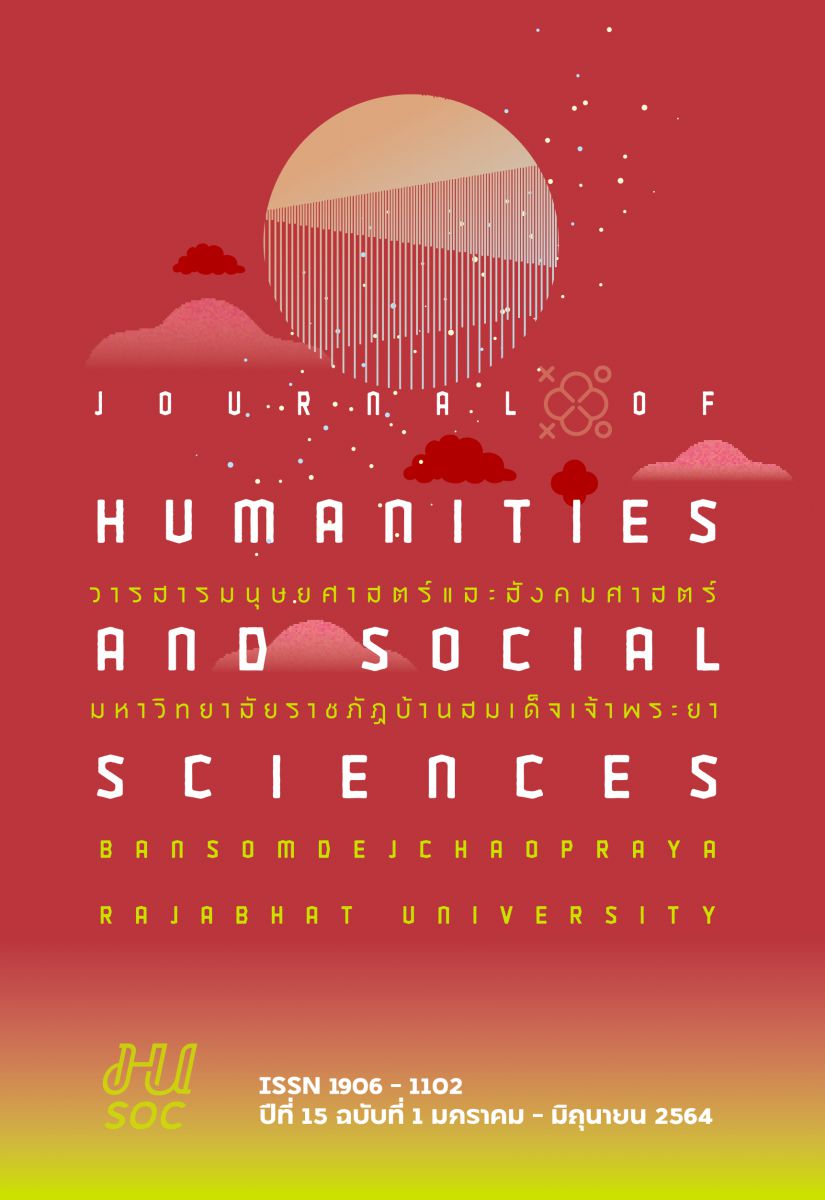“บทเพลง” กับการเสริมสร้างการมีส่วนร่วมในการอนุรักษ์สิ่งแวดล้อมของประชาชนในจังหวัดเชียงใหม่
คำสำคัญ:
ดนตรี, บทเพลง, การอนุรักษ์สิ่งแวดล้อม, ปัญหาฝุ่นละออง, ปัญหาหมอกควันบทคัดย่อ
ปัญหาฝุ่น และหมอกควันโดยเฉพาะฝุ่นละอองขนาด 2.5 ไมครอน หรือ PM 2.5 และฝุ่นละอองขนาด 10 ไมครอน หรือ PM 10 เป็นปัญหาที่คนเชียงใหม่ต้องเผชิญมานานกว่า 14 ปี โดยเฉพาะอย่างยิ่งในปี พ.ศ. 2562ฝุ่นละอองขนาดเล็กในจังหวัดเชียงใหม่ วัดโดยดัชนีคุณภาพอากาศ US AQI มีระดับสูงถึง 246 เป็นอันดับหนึ่งของโลก แสดงให้เห็นว่าความพยายามในการแก้ไขปัญหาสิ่งแวดล้อมที่ดำเนินการโดยภาครัฐไม่ประสบผลสำเร็จดังนั้นการมีส่วนร่วมของประชาชนจึงมีความสำคัญ “บทเพลง” เป็นรูปแบบหนึ่งของ “ดนตรี” ที่ประพันธ์ และได้ถูกนำมาใช้เพื่อสร้างแรงบันดาลใจและจิตสำนึกในการอนุรักษ์สิ่งแวดล้อมมาตั้งแต่หลายทศวรรษที่ผ่านมาบทความนี้มีจุดมุ่งหมายเพื่อแสดงให้เห็นถึงความสัมพันธ์ของดนตรีกับธรรมชาติวิวัฒนาการของการนำบทเพลงมาใช้ในการสร้างแรงบันดาลใจในการอนุรักษ์สิ่งแวดล้อม องค์ประกอบของดนตรีที่ใช้ในการสร้างแรงบันดาลใจในการอนุรักษ์สิ่งแวดล้อม และให้ข้อเสนอแนะองค์ประกอบของบทเพลงที่จะช่วยเสริมสร้างการมีส่วนร่วมในการอนุรักษ์สิ่งแวดล้อมของประชาชนในจังหวัดเชียงใหม่ โดยการประพันธ์บทเพลงดังกล่าวควรพิจารณาถึงความชอบในการฟังเพลงของกลุ่มผู้ฟังเป้าหมายและรังสรรค์ให้องค์ประกอบของเพลงได้แก่ เนื้อหา ทำนอง จังหวะ และเสียงประสาน สามารถตอบสนองรสนิยมทางดนตรีของผู้ฟัง โดยบทเพลงนั้นควรมีสาระสำคัญในการสร้างการเห็นคุณค่าของสิ่งแวดล้อมในท้องถิ่น การตระหนักถึงปัญหาของสิ่งแวดล้อม และท้ายสุดคือการเรียกร้องให้กลุ่มเป้าหมายมีส่วนร่วมในการอนุรักษ์สิ่งแวดล้อมของจังหวัดเชียงใหม่
เอกสารอ้างอิง
คฑาวุธ ทองไทย. (2562, พฤษภาคม-สิงหาคม). การศึกษาเพลงเพื่อชีวิตของไทย: จากแนวพัฒนาการสู่การวิเคราะห์การประกอบสร้างวาทกรรมทางสังคม. วารสารรูสมิแล, 40(2), 15-26.
คมชัดลึก. (2563). บ่าววี ชวนคนรักธรรมชาติ ดูคอนเสิร์ตดนตรีเพื่อธรรมชาติและชีวิต. สืบค้น 22 ธันวาคม 2563, จาก https://www.komchadluek.net/news/ent/88927
คอร์ดอีซี่. (2559). คอร์ดเพลงดอกไม้ Salina & Sarinya. สืบค้น 23 พฤศจิกายน 2563, https://www.chordeasy.net/2016/09/selina-sirinya-flower.html
ตติยา สายบัวพัตร. (2555, มกราคม-มิถุนายน). เพลงโฟล์คซองคําเมืองของสุนทรี เวชานนท์. พิฆเนศวร์สาร, 8(1), 17-24.
เชียงใหม่นิวส์. (2563). My Hometown by RJ เพื่อเมืองเชียงใหม่อันเป็นที่รัก. สืบค้น 8 มกราคม 2564. https://www.chiangmainews.co.th/page/archives/1340705/
ไทยนิวส์รายวัน. (2557). คนเชียงใหม่ชี้สภาพแวดล้อมเริ่มเสื่อมโทรม. สืบค้น 15 มิถุนายน 2563, จาก http://www.thainews70.com/ข่าวเกษตรกรรม/คนเชียงใหม่ชี้สภาพแวดล/
ผู้จัดการออนไลน์. (2561). 10 บทเพลงอนุรักษ์ธรรมชาติ แด่ป่า-แด่สัตว์ที่ไปไม่ถึงต่อมสำนึกของนักล่าสัตว์ใจทราม/บอนบอระเพ็ด. สืบค้น 1 กรกฎาคม 2563, จาก https://mgronline.com/entertainment/detail/9610000012530
ผู้จัดการออนไลน์. (2563). มาดามแป้งเปิดใจ “ในวันที่โลกเปลี่ยนไป”. สืบค้น 1 กรกฎาคม 2563. https://mgronline.com/mutualfund/detail/9630000028709
สำนักงานจังหวัดเชียงใหม่. (2560). ข้อมูลทั่วไปของจังหวัดเชียงใหม่. สืบค้น 15 มิถุนายน 2563, จาก https://www.chiangmai.go.th/managing/public/D8/8D01Feb2017150134.pdf.
หนังสือพิมพ์ไทยโพสต์. (2563). ถอดบทเรียน 14 ปี แก้หมอกควันภาคเหนือ “ล้มเหลว - ซ้ำรอยเดิม” สืบค้น 25 ธันวาคม 2563, จาก https://www.thaipost.net/main/detail/66641
อัจฉรีย์ ทิพธนธรณินทร. (2558, กรกฎาคม - ธันวาคม). แนวทางการแก้ปัญหาหมอกควันสำหรับจังหวัดเชียงใหม่. วารสารด้านการบริหารรัฐกิจและการเมือง. 4(1), 72-105.
โอเคเนชั่น. (2553). จอห์น เดนเวอร์ ยังไม่ตาย. สืบค้น 20 ธันวาคม 2563, จาก http://oknation.nationtv.tv/blog/print.php?id=649176
Abrahams, F. (2015, September). Another perspective: teaching music to millennial students. Music Educators Journal, 102(1), 97-100.
Allen, A. (2012, June). Ecomusicology: music, culture, nature and change in environmental studies? Journal of Environmental Studies and Sciences, 2(2), 192–201.
Arons, W. & May, T.J. (2012). Readings in performance and ecology. New York: Palgrave Macmillan.
Benward, B., & Saker,M. (2014). Music in theory and practice. (9th ed.). New York: McGraw-Hill.
Casas-Mas, A., Pozo, J., & Montero, I. (2014, November). The influence of music learning cultures on the construction of teaching learning conceptions. British Journal of Music Education, 31(3), 319-342.
Collins, J. (2011). Good to great: why some companies make the leap ... and others don’t. New York: Harper Business.
Encyclopedia of Biography. (2020). John Denver biography. Retrieved 1 April 2020, from https://www.notablebiographies.com/supp/Supplement-Ca-Fi/Denver-John.html
Folkestad, G. (2006, June). Formal and informal learning situations or practices vs formal and informal ways of learning. British Journal of Music Education, 23(2), 135-145.
Garett, G. H. (2013). The grove dictionary of American music. (2nd Ed). Oxford: Oxford University Press.
Georgii-Hemming, E. & Westvall, M. (2010, March). Music education—a personal matter? examining the current discourse of music education in Sweden. British Journal of Music Education, 27(1), 21-33.
Hallam, S. (2012). “Commentary: instrumental music.” in The Oxford Handbook of Music Education, I, ed.Gary Macpherson & G. Welch, (pp. 651–57). Oxford: OxfordUniversity Press.
Hallam, S. (2015). The impact of actively making music on the Intellectual, social and personal development of children and young people: a research synthesis. London: IMerc.
Helmick,A. (2011). The greening of American music: environmentalism in song. (Doctoral dissertation), Munchen: Ludwig-Maximilians-Universitat Munchen.
Higgins, L. (2015). My voice is important too: non-formal music experiences and young people. In McPherson, G. (Ed.), The child as musician: a handbook of musical development.Oxford, UK: Oxford University Press.
Ingram, D. (2007, December 2006-March 2007). ‘Go to the forest and move’: American Rock Music as Electric Pastoral. 49th Parallel, 20, 1–16.
Juslin, N. P. & Timmers, R. (2010). Expression and communication of emotion in music performance. In: P. N. Juslin & J. A.Sloboda (Eds.). Music and emotion. Theory, research, applications (453-489). United Kingdom: Oxford University Press.
Manabe, N. (2015). The revolution will not be televised: protest music after Fukushima. NewYork: Oxford University Press.
McPhail, G. (2013, June). Developing student autonomy in the one-to-one music lesson. International Journal of Music Education, 31(2), 160–172.
Pedelty, M. (2012). Ecomusicology. Philadelphia, PA: Temple University Press.
Pedelty, M. (2016). A Song to save the Salish Sea: Musical Performance as Environmental Activism. Bloomington: Indiana University Press.
Rabinovitch, T-C., Cross, I., & Burnard, P. (2013, July). Long-term musical group interaction has a positive influence on empathy in children. Psychology of Music, 41(4), 484-498.
Rehding, A. (2011, May-August). Ecomusicology between Apocalypse and Nostalgia. Journal of the American Musicological Society. 64(2), 409–414.
Rosenthal, D.J. (2006, August). ‘Hoods and the woods: rap music as environmental literature. The Journal of Popular Culture, 39(4), 661–676.
Schafer, R.M. (1994). The soundscape: our sonic environment and the tuning of the world. Rochester, VT: Destiny Books.
Vesper, C., van der Wel, R., Knoblich, G., & Sebanz, N. (2011, June). Making oneself predictable: reduced temporal variability facilitates joint action coordination. Experimental Brain Research, 211(3), 517-530.
ดาวน์โหลด
เผยแพร่แล้ว
รูปแบบการอ้างอิง
ฉบับ
ประเภทบทความ
สัญญาอนุญาต
ลิขสิทธิ์ (c) 2021 คณะมนุษยศาสตร์และสังคมศาสตร์ มหาวิทยาลัยราชภัฏบ้านสมเด็จเจ้าพระยา

อนุญาตภายใต้เงื่อนไข Creative Commons Attribution-NonCommercial-NoDerivatives 4.0 International License.




